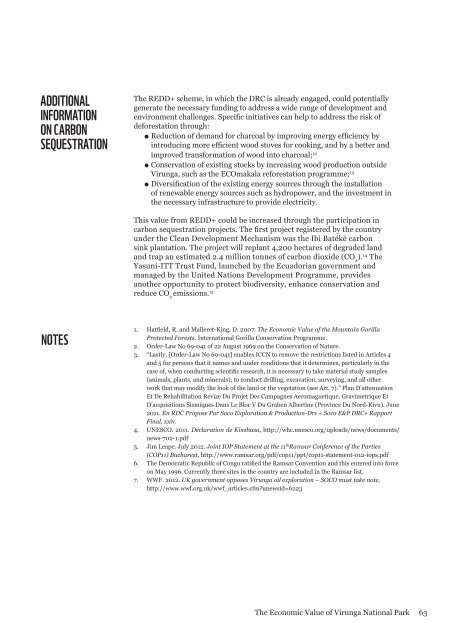The Economic Value of Virunga National Park - World Wildlife Fund
The Economic Value of Virunga National Park - World Wildlife Fund
The Economic Value of Virunga National Park - World Wildlife Fund
You also want an ePaper? Increase the reach of your titles
YUMPU automatically turns print PDFs into web optimized ePapers that Google loves.
ADDITIONALINFORMATIONON CARBONSEQUESTRATION<strong>The</strong> REDD+ scheme, in which the DRC is already engaged, could potentiallygenerate the necessary funding to address a wide range <strong>of</strong> development andenvironment challenges. Specific initiatives can help to address the risk <strong>of</strong>deforestation through:● Reduction <strong>of</strong> demand for charcoal by improving energy efficiency byintroducing more efficient wood stoves for cooking, and by a better andimproved transformation <strong>of</strong> wood into charcoal; 12● Conservation <strong>of</strong> existing stocks by increasing wood production outside<strong>Virunga</strong>, such as the ECOmakala reforestation programme; 13● Diversification <strong>of</strong> the existing energy sources through the installation<strong>of</strong> renewable energy sources such as hydropower, and the investment inthe necessary infrastructure to provide electricity.This value from REDD+ could be increased through the participation incarbon sequestration projects. <strong>The</strong> first project registered by the countryunder the Clean Development Mechanism was the Ibi Batéké carbonsink plantation. <strong>The</strong> project will replant 4,200 hectares <strong>of</strong> degraded landand trap an estimated 2.4 million tonnes <strong>of</strong> carbon dioxide (CO 2). 14 <strong>The</strong>Yasuní-ITT Trust <strong>Fund</strong>, launched by the Ecuadorian government andmanaged by the United Nations Development Programme, providesanother opportunity to protect biodiversity, enhance conservation andreduce CO 2emissions. 15NOTES1. Hatfield, R. and Malleret-King, D. 2007. <strong>The</strong> <strong>Economic</strong> <strong>Value</strong> <strong>of</strong> the Mountain GorillaProtected Forests. International Gorilla Conservation Programme.2. Order-Law No 69-041 <strong>of</strong> 22 August 1969 on the Conservation <strong>of</strong> Nature.3. “Lastly, [Order-Law No 69-041] enables ICCN to remove the restrictions listed in Articles 4and 5 for persons that it names and under conditions that it determines, particularly in thecase <strong>of</strong>, when conducting scientific research, it is necessary to take material study samples(animals, plants, and minerals), to conduct drilling, excavation, surveying, and all otherwork that may modify the look <strong>of</strong> the land or the vegetation (see Art. 7).” Plan D’attenuationEt De Rehabilitation Revize Du Projet Des Campagnes Aeromagnetique, Gravimetrique EtD’acquisitions Sismiques Dans Le Bloc V Du Graben Albertine (Province Du Nord-Kivu). June2011. En RDC Propose Par Soco Exploration & Production-Drc « Soco E&P DRC» RapportFinal, xxiv.4. UNESCO. 2011. Déclaration de Kinshasa, http://whc.unesco.org/uploads/news/documents/news-702-1.pdf5. Jim Leape. July 2012. Joint IOP Statement at the 11 th Ramsar Conference <strong>of</strong> the Parties(COP11) Bucharest, http://www.ramsar.org/pdf/cop11/ppt/cop11-statement-012-iops.pdf6. <strong>The</strong> Democratic Republic <strong>of</strong> Congo ratified the Ramsar Convention and this entered into forceon May 1996. Currently three sites in the country are included in the Ramsar list.7. WWF. 2012. UK government opposes <strong>Virunga</strong> oil exploration – SOCO must take note,http://www.wwf.org.uk/wwf_articles.cfm?unewsid=6223<strong>The</strong> <strong>Economic</strong> <strong>Value</strong> <strong>of</strong> <strong>Virunga</strong> <strong>National</strong> <strong>Park</strong> 63
















